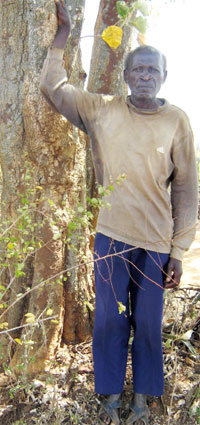By Nanjinia Wamuswa
Just like with animal species, some tree varieties attract more attention than others. Could it be because they are pretty? Probably not.
There is nothing unique about Kitundu, an indigenous tall tree with heart-shaped leaves. The tree goes unnoticed in many parts of the country, but it has a special place in Ukambani. |
Kamba Mutala, the caretaker. Photos: Nanjinia Wamuswa/Standard |
Wherever it grows in this part of the country, it is given special treatment.
And that is why residents of Kyanzasu in Machakos District have reserved space around the only Kitundu tree as a shrine.
And to ensure its deity status, the community appointed a ‘priest’ to take care of the shrine, Ithembo.
The four-metre radius shrine is surrounded with shrubs.
Kamba Mutala, the priest, ensures round-the-clock cleanliness of the shrine. His other duties entail explaining to visitors the dos and don’ts when in the shrine.
Traditional symbol
In the old days, the community sacrificed, celebrated and worshipped at the Ithembo. Thanks to modern religions, it serves more as a traditional symbol than as a place of worship.
If it were the old days, Mutala would be the de facto community spiritual leader of Kitunduni residents. For instance, at such times of drought, he would be preparing to lead the community in a sacrificing session to seek God’s help.
But he has been reduced to a caretaker of the shrine. Born in 1938, Mutala comes from a family of traditional spiritual leaders.
Mr Benjamin Ndunda, a teacher at Makakoi Primary School, says the clouds would start forming just hours after the sacrifice.
"On the day of the sacrifice, we were warned not to graze cattle far away because heavy rainfall was to follow soon afterwards," says Ndunda, grandson to former priest Nzuki Ikindu who reigned in the 1960s.
Mutala explains before any activity took place at Ithembo, Kitundu’s trunk had to be oiled using fat extracted from cow milk.
"Oiling the trunk was meant to appease the gods since they love oil," he explains.
After every harvest, one had to give a portion of the produce for blessings at the Ithembo. This would be followed by a feast. |
Kitindu shrine |
When plants were attacked by locusts, a sheep would be slaughtered and two of its ribs removed. A locust would then be crashed between the two ribs to symbolise the annihilation of the destructive insects. Other activities at the shrine included seeking God’s help during floods and praying for the sick.
Ndunda, who has followed the shrine’s history closely, says the priests were powerful. "These priests led holy lives and could not lie," he says.
Mutala says the Ithembo is recognised by the Provincial Administration, which ensures it is not interfered with.
Besides the belief that anyone who desecrates Kitunda faces severe consequences from ancestors, one also risks heavy fines. One may be required to part with a goat, ram or bull, depending on the crime committed.
Special powers
Residents claim a man who once defied orders and cut a branch from the tree never reached home a sane person.
"He had barely moved 200m away when he was struck with madness," says Mutala.
Today, even children are not allowed to play around it.
Residents believe even dry branches that fall off the tree cannot be used as firewood.
 The Standard Group Plc is a multi-media organization with investments in media
platforms spanning newspaper print operations, television, radio broadcasting,
digital and online services. The Standard Group is recognized as a leading
multi-media house in Kenya with a key influence in matters of national and
international interest.
The Standard Group Plc is a multi-media organization with investments in media
platforms spanning newspaper print operations, television, radio broadcasting,
digital and online services. The Standard Group is recognized as a leading
multi-media house in Kenya with a key influence in matters of national and
international interest.
 The Standard Group Plc is a multi-media organization with investments in media
platforms spanning newspaper print operations, television, radio broadcasting,
digital and online services. The Standard Group is recognized as a leading
multi-media house in Kenya with a key influence in matters of national and
international interest.
The Standard Group Plc is a multi-media organization with investments in media
platforms spanning newspaper print operations, television, radio broadcasting,
digital and online services. The Standard Group is recognized as a leading
multi-media house in Kenya with a key influence in matters of national and
international interest.











